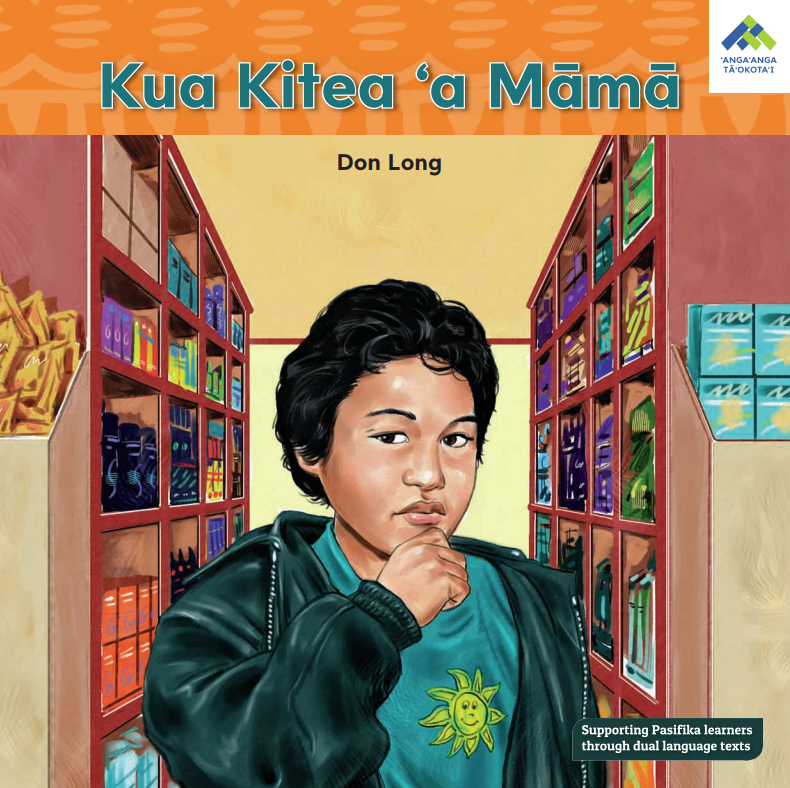Kia orāna young readers, and welcome to Te ʻEpetoma ō Te Reo Māori Kūki ʻĀirani | Cook Islands Language Week 2023!
We hope you’re excited to share and celebrate some of Aotearoa’s closest whānau with us.
Like Aotearoa, Kūki ʻĀirani is a single country made up of multiple islands – 15 in total. They have their own government but are in “free association” with New Zealand. This means that Cook Islanders are New Zealand citizens, free to live and work here as they choose.
The theme of Te ʻEpetoma ō Te Reo Māori Kūki ʻĀirani this year is:
‘Ātuitui’ia au ki te au peu o tōku kāinga ipukarea | Connect me to the traditions and culture of my homeland
And there’s a lot of culture to connect with!
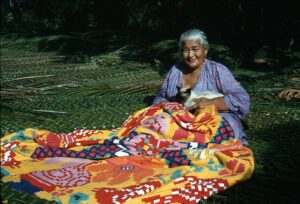
Image: Woman sewing Tivaevae in Rarotonga by John Colles Burland. Alexander Turnbull Library Archive, Ref No. PA12-0503-20.
Te Reo Māori Kūki ‘Āirani (the Cook Islands Māori language) and traditional arts are still proudly shared throughout the islands. Cook Islanders are known for their woodworking skill and textiles, like the patterned Tivaevae quilt.
The Cook Islands are also known for an interesting musical history which has changed over time, mixing traditional music, church music, ukulele and electronic ukulele. Traditional Cook Islands music has a unique and powerful sound, using both wooden drums (lali/pātē) and skin drums (pahu/pa’u), wind instruments, and singing.
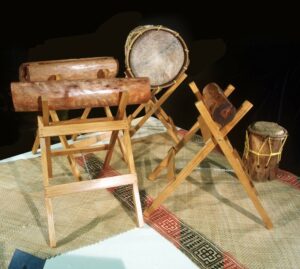
Image: Pa’u mangō (skin drum) from Te Papa Tongarewa, Ref No. FE010085. Licensed under CC BY-NC-ND 4.0.
In the recent Kia Mau Festival — a Māori, Pasifika, and Indigenous arts festival in Wellington — there was a show called ‘Avaiki Nui Social which featured some of the best musicians from across the 15 Cook Islands.
In the video below, Cook Islands artist Tu Aratini talks about ‘Avaiki Nui, and explains some of the history of the group and of music in the Cook Islands. Some other great musicians to check out are father/daughter pair Will and Annie Crummer. Will was quite famous back in the 1960s, and Annie has been rocking it since the ’80s. You can find some of their music, and music by other Cook Islands musicians, on our catalogue!
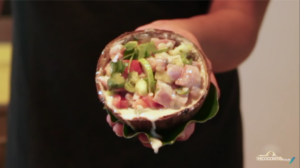
Image: Still from How to make IKA MATA by TheCoconetTV.
As well as music, our Cook Islands whānau are also well known for their food, or kai. Kai from Kūki ‘Āirani often draws on the use of local sea life, with their most popular dish being Ika Mata. Ika mata means ‘raw fish,’ but it actually involves ‘cooking’ the fish by allowing it to soak in lemon juice and coconut.
Sound yum? Check out this “how to” video from TheCoconetTV to learn how to make it for yourself, or check out Sonja’s Kitchen: Sustainable Cuisine from the Cook Islands, a cookbook by Dee Pigneguy and Sonja Raela full of delicious recipes from across the Cook Islands!
Celebrating Te Reo Māori Kūki ‘Āirani in Aotearoa
With such a proud culture back home, it’s not surprising that Cook Islanders in Aotearoa can often feel disconnected, both from their whānau (family) and from their hanua (homeland).
One of the reasons we celebrate Te ‘Epetoma ō Te Reo Māori Kūki ‘Āirani this week is to make sure our Kūki ‘Āirani whānau know that the culture of their homeland is loved and appreciated no matter where they are.
By learning to use more Te Reo Māori Kūki ‘Āirani throughout Aotearoa, we also strengthen our own connection with the world that we all share.
Here are some simple phrases that you can practice with (visit the Ministry of Pacific Peoples’ website for more!):
Hello! — Kia orāna!
Thank you — Meitaki
Goodbye (when you are leaving) — ‘Ē no’o rā
Goodbye (when someone else is leaving) — ‘Aere rā
Yes — Āe
No — Kare
My name is… — Ko … tōku ingoa
Te Reo Māori Kūki ‘Āirani at the Library
Browse our selection of some of our favourite books in Cook Islands Māori, or about the Cook Islands, below. Don’t forget you can find more books in Te Reo Māori Kūki ‘Āirani on our catalogue!
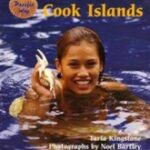 Cook Islands / Kingstone, Taria
Cook Islands / Kingstone, Taria
“Introduces the history, climate, population, social structure and unique ceremonies of the Cook Islands, and the importance of religion to its people. Suggested level: intermediate, junior secondary.” (Catalogue)
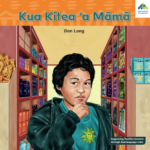 Kua kitea ‘a māmā = Finding mum / Long, Don
Kua kitea ‘a māmā = Finding mum / Long, Don
“In the supermarket, a little boy retraces his footsteps in order to find his mum.” (Catalogue)
Legends of the Cook Islands / Hopkins, Shona
“Collection of eight illustrated legends from the Cook Islands. Set in a mythological time known as Avaiki, these stories tell of brave men and women, mystical mountains, powerful gods and majestic sea creatures. Suggested level: primary, intermediate.” (Catalogue)
Cook Islands heroes / Riley, David
“Cook Islands Heroes tells the inspirational stories of achievers who have Cook Islands ancestry. It includes legends like Ina, Māui, Ngaru and Ru; historical figures such as Pa Tuterangi Ariki/Sir Thomas Davis, Alistair Te Ariki Campbell, Mautara and Margharet Matenga; and contemporary heroes like Lima Sopoaga, Mīria George, Dr Kiki Maoate, Kevin Iro, and Teremoana Raply.” (Publisher description)
‘Ei for the day / MacGregor, Jill
“Yvette and Kiikii wear an ‘ei and an ‘ei katu when their dance group performs at the Saturday Morning Market in Rarotonga.” (Catalogue)



